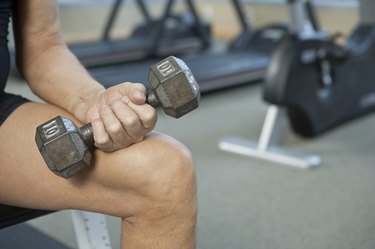
No matter what your age, it's important to stay fit and healthy. Age-related muscle decline is a common issue, so it's even more important in your later years to focus on building and maintaining muscle. If you're 40 and you're looking to get some big muscle gains, you need the right combination of cardio activity and strength-training exercises, along with a high-protein diet and plenty of rest.
Use Cardio to Blast Fat
Video of the Day
The main goal of cardio isn't for building muscle, but rather for fat loss, to show those muscles underneath the layers of fat that you work so hard to obtain. Cardio activity is any type of exercise that gets your heart rate going and improves the amount of oxygen in your blood, blasting away calories and helping you shed layers of body fat that sits over your muscle. Brisk walking, jogging, running, jumping rope, cycling, rowing and jumping jacks are all excellent forms of cardio for a 40-year-old male.
Video of the Day
Incorporate Weights for Big Gains
Strength-training exercises are essential if you want to gain muscle size. If you're 40 and you want to gain muscle, try holding a dumbbell in each hand when you're performing squats -- this builds muscle in your quads, hamstrings and glutes. Don't focus on only one area of your body, as this can result in "strength imbalances and postural difficulties" among other issues, according to the American Council on Exercise. You'll want to integrate dumbbell curls, rows, flyes and triceps kickbacks, along with pushups, bicycle crunches and planks. The best way for you to gain muscle is to follow a routine that has you lifting until your muscles fatigue -- two or three sets will do the trick. Since it's size you're after, stick to the maximum amount of weight you can handle, with fewer total reps, to build strength and promote maximum muscle gains.
Create an Effective Workout Schedule
Creating the right workout schedule is an integral part of gaining lean muscle mass. To avoid injury, start off with a single set of eight to 12 reps or until fatigue, and gradually work your way up to three sets of 12 reps or two sets of 20 reps for alternating exercises. If you're trying to gain muscle, perform your strength-training workout on Monday, Wednesday and Friday, and your cardio routine -- such as 10 minutes of brisk walking, 10 minutes jumping rope, 10 minutes on the rowing machine -- on Tuesday, Thursday and Saturday.
A High-Protein Diet Makes a Difference
Nutrition plays a major role when you're trying to get and stay fit, especially when your main focus is on building muscle. Protein is essential for the body because it contains amino acids, which are responsible for the strength, repair and rebuilding processes inside your body. Foods that are high in protein, such as lean meats, tofu, eggs, nuts and certain grains are important to include in your diet. If you're not getting enough protein in your diet, you won't get the muscle gains you're after.
Things to Think About Before Starting
As you age, you can become more prone to exercise injuries. Talk with your doctor before starting with any new exercises, especially if you have any existing health issues or are dealing with the effects of a past injury. You may also want to work with a fitness professional to discuss your goals and get help creating the most effective, personalized workout plan for yourself.